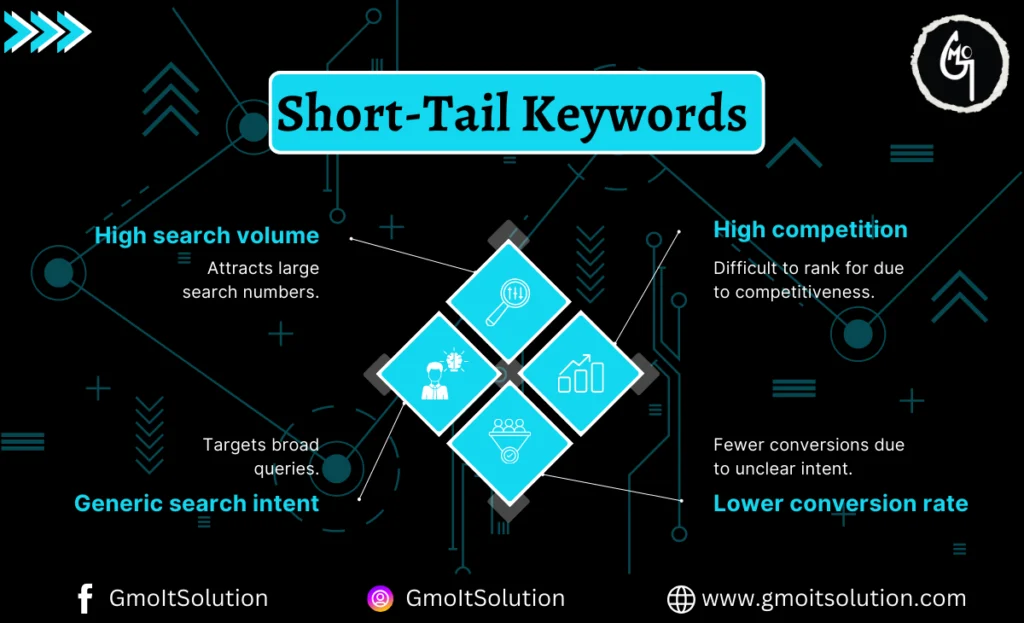Short-Tail Keywords
In the competitive field of digital marketing, selecting the right keywords may make or break your SEO strategy. You can miss out on an important amount of traffic if you don’t know the difference between long-tail and short-tail keywords. Therefore, what are short-tail keywords and how can you use them in your SEO plan? Let’s explore what short-tail keywords are, how they are different from long-tail keywords, and why it’s important to balance the two.
Why Short-Tail Keywords Matter
Anybody in SEO wants to be number one for the most popular terms. Because of their wide appeal, short-tail keywords like “shoes” or “laptops” sometimes attract a lot of traffic. Here’s the problem, though: Keywords with short tails are quite competitive. It can be disappointing for small businesses to attempt to rank for these wide keywords. Also, they often do not have the characteristics needed to target visitors who have specific goals in mind, which might result in low conversion rates.
What exactly is a short-tail keyword then? Usually, keywords have a broad scope and range in length from one to three words. These terms are more popular but also produce a lot of search volume.
Example of short-tail keywords
- Marketing
- SEO tools
- Online courses
These broad terms cast a wide net, resulting in a large number of searches, but they don’t always match the user’s specific intentions.
The Struggle with Balancing Short-Tail vs. Long-Tail
While short-tail keywords increase traffic, they also have a higher rate of bounce and usually don’t result in a sale. Since they appeal to a wide audience, visitors using short keywords might not find what they’re looking for on your website. The question of short-tail vs. long-tail arises at this point.
Short-Tail vs. Long-Tail Keywords
Intention is the primary difference between long-tail and short-tail keywords. Long-tail keywords (like “bi running shoes online”) focus on specific intent and have a higher rate of conversion than short-tail keywords, which are more appropriate for wide searches. Long-tail keywords with three or more words are more specific and have less competition, which could result in focused visitors.
Should your SEO approach only depend on short keywords, you run the danger of losing out on really relevant visitors. While conversion rates may be a challenge for short-tail SEO strategies, they frequently focus on brand awareness. However, long-tail keywords in SEO let you focus on a particular user search, drawing in a more engaged audience.
How to Leverage Both Long Tail Keywords and Short Tail Keywords
A successful SEO strategy needs to find a balance between long-tail and short-tail keywords. Long-tail keywords target audiences who are prepared to convert, while short-tail keywords help you become more visible and draw in more visitors.
Step 1: Identify Your Core Short-Tail Keywords
First, identify which short-tail keywords are most important to your company. These tend to be both general and industry-specific. If you have a fitness blog, for example, your short-tail keywords could be “workout,” “exercise,” or “fitness.” Your SEO approach should be built around these terms, which ought to represent your brand.
Examples of short-tail keywords
- Yoga
- Digital marketing
- Social media tips
Step 2: Pair Short-Tail Keywords with Long-Tail Keywords
Long-tail keywords like “best yoga mats for beginners” or “affordable digital marketing tools” will help you connect with people who are more advanced in their buyer’s journey while your short-tail keywords increase brand awareness. A balanced strategy that attracts to both frequent visitors and prospective customers is created by combining short- and long-tail keywords.
Example of Long Tail Keywords
- Best online fitness programs for women
- Affordable social media management tools for small businesses
Step 3: Optimize Your Content for Short and Long Tail Keywords
Add both long-tail and short-tail keywords to your text now. For example, you might create a blog article that is optimized for the short-term “running shoes,” but you could also target more specific inquiries with long-tail keywords like “best running shoes for marathon training.” To ensure that your text flows and appeals to readers, use natural language.
Step 4: Analyze and Adjust Your Strategy
Search engine optimization is dynamic. Keep an eye on your performance and modify your strategy as needed. You should think about modifying your content to target particular search intents if you find that your short-tail keywords are bringing in traffic but not conversions. On the other hand, if long-tail keywords are generating quality leads, then increase your investment in these strategies.
Conclusion
Maximize your SEO impact by using both long-tail and short-tail keywords. Long-tail keywords convert users who are specifically searching for something, while short-tail keywords generate traffic. For maximum effects, balance both in your plan rather than letting one overshadow the other. Both your audience and your content will appreciate it.




Pingback: Mastering Keyword Research Strategies for Effective SEO
Pingback: Long-Tail Keywords: Boost SEO and Get More Traffic